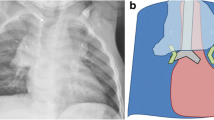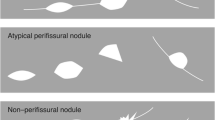Abstract
Background: The presence of mediastinal or hilar adenopathy is critical for the diagnosis of pulmonary TB. Interobserver variability in the detection of lymphadenopathy on CT in children affects the usefulness of CT as a gold standard. Objective: To determine the interobserver variability for the detection of hilar and mediastinal adenopathy on CT in children. Materials and methods: One hundred children with clinically suspected pulmonary TB were prospectively recruited for CT scanning of the chest. Four observers reviewed the scans independently for the presence of lymphadenopathy at predetermined sites. Overall Kappa statistic was determined for each recognised site of mediastinal and hilar lymphadenopathy. Results: Kappa statistics showed that observers only agreed moderately in their detection of lymphadenopathy. The site of best agreement was the right hilum, followed by the subcarinal, right paratracheal and precarinal locations. Observers differed most at the anterior mediastinum and left hilum. The best Kappa statistic was for the overall presence of lymphadenopathy taking all sites into account. Conclusions: Imaging techniques that are considered the gold standard for particular diseases must be validated pathologically, and if this is not possible, interobserver variability should be evaluated. CT is considered the gold standard for detecting lymphadenopathy, but we have shown only moderate agreement between readers. Readers had difficulty in distinguishing lymphadenopathy from normal thymus and were unable to distinguish normal from pathological nodes without a predetermined size threshold for abnormality. The right hilum and the sites around the carina are the most reliable for the reported presence of lymphadenopathy.
Similar content being viewed by others
References
Fletcher BD, Glicksman AS, Gieser P (1999) Interobserver variability in the detection of cervical-thoracic Hodgkin’s disease by computed tomography. J Clin Oncol 17:2153–2159
Schaaf HS, Beyers N, Gie RP, et al (1995) Respiratory tuberculosis in childhood: the diagnostic value of clinical features and special investigations. Pediatr Infect Dis J 14:189–194
Delacourt C, Mani TM, Bonnerot V, et al (1993) Computed tomography with a normal chest radiograph in tuberculous infection. Arch Dis Child 69:430–432
Koch GG, Landis JR, Freeman JL, et al (1977) A general methodology for the analysis of experiments with repeated measurement of categorical data. Biometerics 33:133–158
Landis JR, Koch GG (1994) The measurement of observer agreement for categorical data. Biometrics 33:159
Salazar GE, Schmitz TL, Cama R, et al (2001) Pulmonary tuberculosis in children in a developing country. Pediatrics 108:448–453
Du Toit G, Swingler G, Iloni K (2002) Observer variation in detecting lymphadenopathy on chest radiography. Int J Tuberc Lung Dis 6:1–4
Andronikou S (2002) Pathological correlation of CT-detected mediastinal lymphadenopathy in children: the lack of size threshold criteria for abnormality. Pediatr Radiol 32:912
Wiliams JA, Kaste SC, Kauffman WM, et al (1997) Use of chest computed tomography in the staging of pediatric Wilms’ tumour: interobserver variability and prognostic significance. J Clin Oncol 15:2631–2635
Cascade PN, Gross BH, Kazerooni EA, et al (1998) Variability in the detection of enlarged mediastinal lymph nodes in staging lung cancer: a comparison of contrast-enhanced and unenhanced CT. Am J Roentgenol 170:927–931
Guyatt GH, Lefcoe M, Walter S, et al (1995) Interobserver variation in the computerised radiographic evaluation of mediastinal lymph node size in patients with potentially resectable lung cancer. Chest 107: 116–119
Webb WR, Sarin M, Zerhouni EA, et al (1993) Interobserver variability in CT and MR staging of lung cancer. J Comput Assist Tomogr 17:841–846
Hopper KD, Kasalas CJ, Van Slyke MA, et al (1996) Analysis of interobserver variability in CT tumour measurements. Am J Roentgenol 167:851–854
Bollen EC, Goei R, v’t Hof-Grootenboer BE, et al (1994) Interobserver variability and accuracy of computed tomographic assessment of nodal status in lung cancer. Ann Thorac Surg 58:158–162
Author information
Authors and Affiliations
Corresponding author
Rights and permissions
About this article
Cite this article
Andronikou, S., Brauer, B., Galpin, J. et al. Interobserver variability in the detection of mediastinal and hilar lymph nodes on CT in children with suspected pulmonary tuberculosis. Pediatr Radiol 35, 425–428 (2005). https://doi.org/10.1007/s00247-004-1383-5
Received:
Accepted:
Published:
Issue Date:
DOI: https://doi.org/10.1007/s00247-004-1383-5




